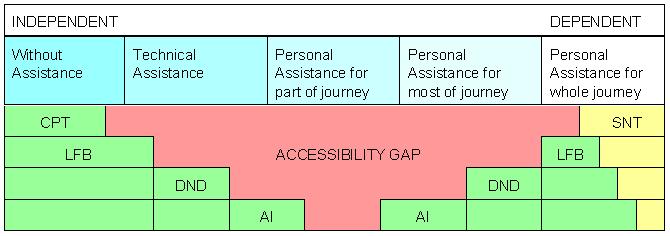
APEX set out to establish a means to evaluate accessibility for disabled people in reaching and using the public transport system.
Two views of disability:
| Medical: | an infirmity, impairment etc. which means that a person cannot breach a barrier. |
| Social: | barriers are designed in such a way that some people cannot breach them. |
There are three types of barrier to consider when thinking about accessibility:
| Physical | Sensory | Cognitive |
| Distance | Legibility | Clarity |
| Widths | Tactile Surfaces | Simplicity |
| Gaps | Audibility | Ease of understanding |
To design these barriers so that more people can use public transport independently, we have to understand how the barriers act on different people. The APEX research studied a group of people in East London in order to formulate an approach to the assessment of accessibility. This broadened previous research in this field.
For example:
95% of the sample could read a timetable if it were produced in 26 point font size but the timetables would be very large.
90% could read the timetable if the font size were printed in 20 point type.
70% could read a timetable produced in 12 point Lucida Sans font
However, nobody could read the leaflets produced by the local operator in 7 point text.

| CPT | = | Conventional Public Transport |
| SNT | = | Special Needs Transport |
| LFB | = | Low Floor Buses |
| DND | = | Dense Network Design |
| AI | = | Accessible Information |
An improvement in accessibility could enable someone to find travelling easier or to move from one category of assistance to another and so increase their independence as well.
Research Team: Natasha Brown, Farzaneh Bitarafen, Martha Caiaffa, Nick Tyler
(Back to the APEX main page)